TP-Link Kasa Cam Wireless Camera Review
Pros
Cons
Rating
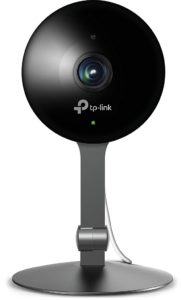
Introduction
We’ve tested a huge number of wireless cameras over the past few years, so many in fact that we’ve got a stack of them in a corner just waiting to be given away. The truth is that most so-called “smart” cameras on the market today aren’t just pretty dumb, they’re also pretty poor examples of modern technology. Clearly, a whole bunch of second-rate companies have entered into this market to grab some market share among security-obsessed, smartphone-loving consumers. And amazingly, this feeding frenzy has attracted huge amounts of venture capital funding for big new concepts that turn into ultra-expensive, poorly-engineered finished products.
So let’s get this out of the way right now: TP-Link’s Kasa Cam is not one of these. In fact, among the dozen or so wireless cameras we’ve tested, it’s right near the top, and we don’t mean the top of the give-away pile! This shouldn’t be too surprising, because TP-Link also makes some of the best networking gear on the market, often dominating the charts in our quarterly Wireless Networking Buyer’s Guide. When TP-Link reached out to us to let us know about its first Smart Home camera, we jumped at the opportunity to put it under the microscope, so to speak.
Read on to find out where the Kasa Cam beats the competition, and where it could still use a little fine-tuning.
We’d like to extend a special thank you to TP-Link for providing a sample of the TP-Link Kasa Cam KC120 Wireless Camera for review.
Description and Features
First things first, TP-Link is not new to wireless cameras, so what makes this one different? Based on our pre-release briefing with the company, the KC120, or Kasa Cam, is its first “Smart Home” camera. Now, what Smart Home means to one person or another is certainly up for debate, but from TP-Link’s point of view, Smart Home means cloud integration, enhanced security, a smartphone interface, and a better overall user experience. Summed up, and we quote, TP-Link believes the Kasa Cam will be “a delight, not a hassle.” Fair enough. We’ll discuss its Smart Home attributes a bit more later in this review, but there’s no doubt that the Kasa Cam is certainly a premium offering, and it’s clearly a break from the previous no-frills models that TP-Link has offered.
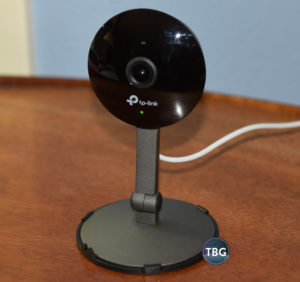
All right, let’s get into some specifics regarding the Kasa Cam. In the box, you’ll find just a couple of parts, a quick-start guide, and notably no manual. The lack of a manual is becoming more and more commonplace with gear designed around a smartphone interface, but the fact that there’s no manual at all, not even on the TP-Link website, irks us just a bit. Yes, we know it’s designed to be easy to use, but a listing of its basic functions would be helpful at a minimum. As it stands, you’ll learn more about this product by reading about it on a retailer’s website than you will once you have it in your hand. That just seems a bit backwards to us.
As for the components in the box, you’ll find the camera, a plastic disc that serves as a wall mount, a white micro-USB cord, and a power adapter. The adapter is very small, and thanks to its white color, it blended right into the bottom of the box, which at first left us scracthing our heads wondering if an adapter hadn’t been included at all. Note that while the Kasa Cam itself is decked out in glossy and satin black, the white cord and adapter clash a bit. TP-Link informed us that this color was chosen to better blend in with home decor, although where the cable has to be exposed for some length of the run, as in our installation, white ends up being more noticeable than black would have been. Luckily, the user can always substitute their own black cable if they wish.
A bigger concerns is that TP-Link’s adapter follows the bad example set by so many other Smart Home products nowadays, sticking out several inches from the wall. We’ve had the same problem with all of Amazon’s Echo products, as well as various Smart Home alarms and outlets. For a camera that is likely to be placed on furniture and made to blend in, it’s a little shocking that product designers don’t realize that outlets in actual homes, as opposed to test labs, are often behind furniture. There’s no way you’re going to be able to push a cabinet closer than two inches from the wall with TP-Link’s adapter in an outlet behind it. Again, this is most definitely not specific to TP-Link, but it is something we hope the company will consider fixing in the next revision.
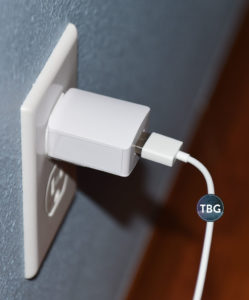
The Kasa Cam uses a 130-degree wide-angle lens, which means it offers a lot of coverage despite the lack of pan-and-tilt functionality that many off-brand wireless IP cameras include. Our guess is that the cost of a proper wide-angle lens is actually more than the pan-and-tilt mechanism, which is why we consider a wide-angle lens the higher-end choice. For just about any user, pan-and-tilt is a gimmick with little benefit. The Kasa Cam can also be manually tilted up and down from nearly 90 degrees, providing a lot of flexibility, including the ability to be mounted to a wall. And very unique feature the Kasa Cam offers is the ability to have the camera begin recording and send an alert when triggered by sound, in addition to motion. This is critical in various situations, from a baby crying (but not moving enough to trigger motion detection) to glass breaking off camera. Note that this feature is off by default, but can be turned on easily if desired.
Now, let’s get down to price, or more accurately, pricing. When it comes to security cameras, we think most of the startup camera manufacturers were hoping to cash in on expensive subscription plans that consumers won’t realize they need until it’s too late. The huge negative response in online user reviews suggests this was a bad idea, and that there will be some sad panda venture capitalists in silicon valley. Luckily, TP-Link is not a startup, and can actually provide a great package out of the box. The Kasa Cam costs just $129.99, which we should note is the lowest MSRP of any name-brand wireless camera. Even better, it includes one gigabyte of free recording, which TP-Link estimates will last about two days. We’ll discuss the pros and cons of this approach on the next page, but suffice it to say that running the Kasa Cam in your kitchen is going to translate to that storage being consumed pretty quickly (recording only occurs when motion or sound is detected, not 24/7). If you determine you need more storage, you can get 14 days of storage for $4.99/month, or 30 days of storage for $9.99/month. A big question for serious users will be whether additional cameras will cost just as much, or whether the subscription covers multiple cameras. Either way, TP-Link is ahead of popular competitors like Google’s Nest Cam, which provide exactly 0GB of recording for free. Interestingly, while a lot of cheap cameras have featured both cloud and onboard storage, TP-Link decided to go cloud-only with this product. Given how much more user-friendly a cloud-based camera can be, we think this is a perfectly-reasonable decision. Onboard storage is really an antiquated approach at this point.
One last thing: TP-Link, being a wireless networking company, knows a thing or two about security. It endows the Kasa Cam with 128-bit SSH encryption, rather than leaving security to the router. This should put to rest any fear among potential buyers of easy exploits leading to hacked cameras any time in the near future!
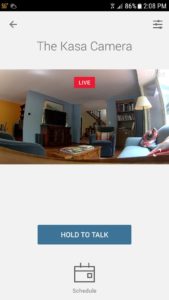
Performance
To get the Kasa Cam up and running, we first had to download the Kasa app to our Android smartphone. TP-Link has a number of apps in the Play Store, and in fact we’ve used several of them for past reviews, including the Deco app for whole-home WiFi, and the Tether app for traditional routers. There’s also an older TP-Link camera app, so you’ll need to make sure you download the Kasa app for use with the Kasa Cam. Note that the Kasa app is not a new app, and the Kasa Cam is definitely not the first device to use it. In fact, TP-Link’s entire suite of Smart Home products relies on the Kasa app, but the Kasa Cam is the very first product to adopt the creative take on the Spanish word “Casa”, meaning home, into the actual product name. Our only question is what took you so long, TP-Link? Kasa Cam is far catchier than, for example, the LB130 Smart Wi-Fi LED Bulb with Color Changing Hue or the HS110 Smart Wi-Fi Plug with Energy Monitoring. Honestly, we think a good part of the success of many Smart Home products, for better or for worse, stems from having a likable name. Nest cam, Ring doorbell cam, Canary alarm, you get the idea.
We had a bit of trouble getting the app to detect our camera automatically, and had to switch to manual connection mode, but once we did that, the camera was online in just a few seconds. All things considered, this was probably the fastest setup process we’ve come across. One quirk that every Smart Home cam we’ve tested so far, including this one, has shared is that a hard reset is required to change your wireless network. Given the powerful smartphone interface, we really, really wish we could just change the network for our camera with a simple click. Perhaps there’s a technical reason a reset is required, but it’s still a pain for anyone who upgrades their router, or just wants to see which wireless band (for example, 2.4GHz or 5GHz) is faster. Note that the Kasa Cam is the very first camera we’ve seen that offers 802.11ac networking, although it’s limited to a single 433Mbps stream. Even so, it’s going to be a huge step up from typical 802.11n networking for a lot of users who have a modern router available. Because we were testing our Kasa Cam on the opposite side of the house from where the router was located, we actually decided to use 802.11n, which although limited to 150Mbps in the Kasa Cam, always offers slightly better range. We had no issues with bandwidth-related slowdowns.
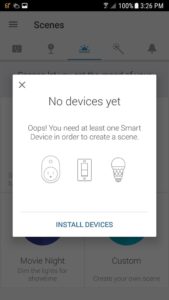
In practice, the app was easy to use, but it has a relatively busy interface, resulting from the fact that it’s intended for use with multiple product lines, including TP-Link’s aforementioned bulbs and switches. In fact, one of the five control panels in the app, the Scenes control, responded with the warning “No devices yet,” which was a bit discouraging, as well as incorrect. TP-Link ought to deactivate that section of the app until appropriate devices are connected. The Kasa app’s main camera interface is pretty basic, with a Hold to Talk button along with a schedule button. The latter takes you to a screen with only a single option: turning the camera on and off at certain times (or more accurately, engaging privacy mode, which leaves it powered on but shuts off the video feed). It would really be ideal if you could schedule the camera to only provide notifications at certain times, but stream 24/7. For example, if you place the camera in your kitchen, the last thing you’ll want is to receive smartphone notifications every time someone walks in front of the camera during dinnertime. On the other hand, you’d probably want to know if someone is snooping around the kitchen in the middle of the night. Alas, there’s no option for that in the version of the app we tested. TP-Link’s respresentative suggested that a work-around is to silence alerts via your phone during periods of the day when you are not concerned about security (i.e., when you’re in the house and kids are running around). We hope, however, that additional scheduling options are eventually added to the Kasa app as well.
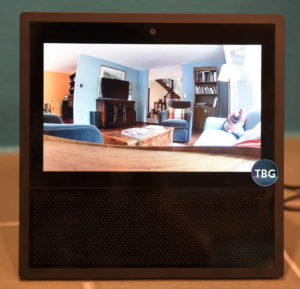
How you interact with the Kasa Cam will depend on your particular needs, but we found that having the option to display a live feed on our Amazon Echo Show was very useful. Whether you want to keep an eye on the baby in the nursery or who’s at your front door, this type of integration is going to become increasingly mandatory in Smart Home products. To enable this functionality, you need to enable the Kasa skill through the Amazon Alexa app. Note that no instructions are provided by TP-Link in this regard, and the feature isn’t even mentioned on the package, so you’ll hopefully be somewhat familiar with how Alexa skills work before you try to get it up and running. Somewhat humorously, our Show had a very hard time finding our camera when we named it “The Kasa Camera,” but had nearly 100% success when it was named “The Casa Camera.” Alexa’s a stickler for correct spelling, even in another language, apparently.
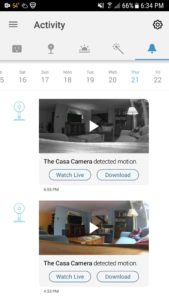
Of course, one of the biggest features of the Kasa Cam is the ability to review recorded video, and for most users interested in things like knowing when the baby woke up or when the mailman dropped off a package (or a theif stole it), this feature is critical. The interface for retrieving stored videos isn’t particularly inspiring, but it’s quite functional. You can easily find videos by date and time, and you have the option of either viewing them or downloading them. In an apparent editing error, TP-Link labels the button for viewing recorded videos as “Watch Live” – we think TP-Link actually means “Watch Now” or simply “View.” Note that like most current Smart Home camera offerings, the Kasa Cam has no PC or Mac interface – the Kasa smartphone app is your only option for viewing a feed other than Amazon’s Echo Show.
One thing we should do before we wrap up our review is to touch upon actual performance. TP-Link informed us that it worked very hard to cut latency down to near-zero, and the results speak for themselves. While launching the Kasa app took about five seconds on our Samsung Galaxy S7, accessing a live feed via the Kasa app took under one second, which is simply superb. Many of the other Smart Home cameras we’ve tried have taken closer to five seconds to connect even once you’re in the app, which can be agonizingly-long if you actually have a concern about security or a family member. We were also very impressed with the quality of the 1080p video feed – too many cameras claim to have 1080p resolution but look terrible in real-world use. The Kasa Cam provided a clear picture, excellent color reproduction, and very impressive detail in night vision mode as well. Overall, TP-Link’s Kasa Cam gets an “A” for performance. By the way, TP-Link informed us that the Kasa Cam unofficially supports the use of USB-based battery packs, such as those you’d use to charge a phone. We didn’t test this feature, but for intrepid users, it might be worth tinkering with for short-duration use where there’s no outlet around.
Conclusion
We focused a lot on pricing earlier in this review because it’s one of the features that most distinguishes the Kasa Cam from its competitors. With the lowest MSRP of any name-brand Smart Home camera and the most generous free recording package, TP-Link nearly ensured a slam dunk right from the start. And as a stand-alone camera for home monitoring, it really is. But a few things hold it back from being perfect. We’ve already addressed some minor issues in this review, but perhaps the biggest requires taking a step back and really thinking about what it means to be a Smart Home product. In our opinion, for the Kasa Cam to be a true Smart Home camera, we think it really has to have some Smart Home integration. The fact that TP-Link hasn’t yet integrated it into its own Smart Home ecosystem is kind of mind-boggling. Using it as a trigger for TP-Link’s own bulbs and switches seems like such an obvious step to us, and in fact TP-Link is the only manufacturer in the world that offers both cameras and bulbs. We assume it’s coming, but really, shouldn’t it be here already? We’re guessing that TP-Link assessed the market and determined that the vast majority of users just don’t care about home automation, and are simply looking for a simple-to-use camera that offers some peace of mind, without the dreaded required subscription plan. If that sounds like you, the Kasa Cam will not disappoint.
The TP-Link Kasa Cam is available for $129.99 shipped from Amazon, as of our publication date. It’s a tremendous value, as well as one of the very few wireless cameras we feel comfortable recommending to our readers.
For all of our favorite picks in the Smart Home arena, check out our Smart Home Buyer’s Guide, updated quarterly.

